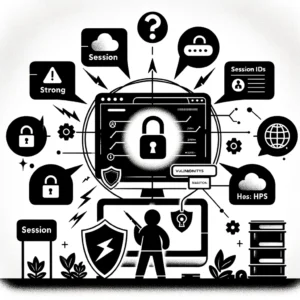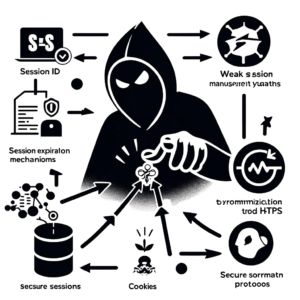Understanding Session Management Vulnerabilities
Session management vulnerabilities in web applications pose a significant risk to the security of user data and sensitive information. Hackers exploit these weaknesses to hijack user sessions, gaining unauthorized access to accounts and potentially compromising the entire system.
To protect against session management vulnerabilities, web developers must implement secure session handling practices. This includes using strong session IDs, implementing session expiration mechanisms, and enforcing secure communication protocols such as HTTPS.
Additionally, it’s important for developers to not save important information in cookies. Instead, they should use secure server storage for sessions. By regularly checking and reviewing how sessions are managed, any potential problems can be found and fixed before they are taken advantage of by hackers.
By focusing on keeping sessions secure and following recommended practices for managing sessions, websites can greatly decrease the chances of someone taking over a session or gaining unauthorized access. This helps to safeguard users’ information and keeps the system running smoothly.
Significance of Session Security in Web Applications
In today’s digital world, the security of sessions in web applications is paramount to protect user data and privacy. Session security ensures that unauthorized access is prevented, and user sessions remain confidential and secure. Session management vulnerabilities in web applications can lead to various cyber threats such as session hijacking, session fixation, and session timeout issues.
One effective way to protect against session management vulnerabilities in web applications is to use secure session cookies that are encrypted and have a short lifespan. Session tokens should be generated using strong cryptographic algorithms and validated on each request to mitigate the risk of unauthorized access. Implementing mechanisms such as CSRF tokens, secure headers, and regular session validation checks can also enhance the overall security of web application sessions.
Web developers can protect user sessions and prevent security breaches by making sure sessions are secure and following best practices. It’s important for organizations to stay vigilant and update their security regularly to protect sensitive user data from cyber threats.
Common Session Management Vulnerabilities
Session hijacking is a serious security threat that can compromise the integrity of web applications. Hackers exploit session management vulnerabilities to gain unauthorized access to user sessions, allowing them to impersonate valid users and carry out malicious activities. To protect against session hijacking, web developers must implement robust security measures.
One essential strategy is to use secure communication protocols such as HTTPS to encrypt session data during transmission, making it harder for attackers to intercept and tamper with sensitive information. Additionally, implementing strong session ID generation techniques, such as using random, unpredictable session tokens and setting appropriate session timeouts, can help mitigate the risk of session hijacking.
Regularly monitoring and auditing session activities, detecting abnormal session behavior, and implementing mechanisms like session revocation and re-authentication can also enhance the security posture of web applications against session hijacking attacks. By staying vigilant and proactive, web developers can effectively protect their users’ sessions from unauthorized access and maintain the confidentiality and integrity of data.
Session Sidejacking
Session sidejacking, which is also known as session hijacking, is a type of attack that cybercriminals use to steal user sessions and access web applications without permission. This attack happens when the hacker intercepts session tokens or cookies, which lets them pretend to be the real user and do harmful things. To stop these kinds of attacks on web applications, it’s important to have strong security measures in place.
A simple way to protect your online information is by using HTTPS encryption on websites. This means that data sent between your computer and the website you’re visiting is scrambled, making it harder for hackers to steal your sensitive information like login details. Another way to stay safe is by using secure cookies that have special security features to stop attackers from hijacking your online sessions.
In addition, keeping an eye on user activity and checking for any unusual behavior can help identify if someone is trying to hijack a session. By following good practices for managing user sessions, websites can improve their security and keep unauthorized users from getting in.
Preventive Measures against Session Vulnerabilities
Session management is really important for keeping your information safe when you use websites. It helps to make sure that you are who you say you are while you are using the site. But, bad people can try to break into your session and steal your information. That’s why it’s crucial for website developers to use strong methods to protect your session and keep your data safe.
One key technique is to use random session IDs that are long and complex to reduce the likelihood of session hijacking. Additionally, implementing secure cookies with the ‘HttpOnly’ and ‘Secure’ flags can help prevent session data from being accessed by malicious actors through cross-site scripting attacks.
Regularly expiring and regenerating session tokens or cookies can also help mitigate the risk of session fixation attacks. Furthermore, implementing proper logout functionality that invalidates the session token on the server-side can prevent unauthorized access to the user’s account.
By using these recommended practices for managing user sessions and keeping up-to-date on the latest security threats and trends, developers can effectively safeguard web applications against vulnerabilities related to session management, improving overall cybersecurity.
Implementation of Security Policies
Protecting your online accounts from hackers is crucial. One way they can access your personal information is through session management vulnerabilities. To keep your accounts safe, it’s important for organizations to have strong security policies in place.
One key aspect of implementing security policies is to regularly review and update session management mechanisms. This includes using secure session tokens, implementing session expiration mechanisms, and utilizing secure cookie settings. By regularly auditing and updating these mechanisms, organizations can mitigate the risk of session hijacking attacks.
Moreover, companies need to set up systems that control who can access important data and features in order to protect them. By restricting what users can do and using extra steps like verifying their identity in multiple ways, companies can make it harder for hackers to take advantage of weaknesses in how sessions are managed.
In summary, having strong security rules is important for keeping web applications safe from session management issues. By being careful, keeping security measures up to date, and controlling who has access, organizations can greatly lower the chances of unauthorized access and data leaks.
Tools and Practices for Session Security
When it comes to protecting web applications against session management vulnerabilities, the use of security testing tools is vital. Security testing tools are designed to identify and evaluate potential security weaknesses within the application, including vulnerabilities related to session management.
Businesses can use security testing tools like Burp Suite, OWASP ZAP, and Nessus to find and fix session management vulnerabilities before they are taken advantage of by hackers. These tools scan applications thoroughly to identify security issues, giving developers and security experts a better idea of the risks involved in managing user sessions.
Through the use of automated scans, manual testing, and ethical hacking techniques, security testing tools can simulate real-world attacks to uncover weaknesses in session management implementation. By leveraging these tools effectively, organizations can strengthen their defense mechanisms and enhance the overall security of their web applications.
Adherence to Secure Coding Practices
It’s important to use secure coding practices to protect web applications from session management vulnerabilities. These vulnerabilities can make user data vulnerable, compromise authentication, and allow unauthorized access to sensitive information. By following best practices in secure coding, developers can lower the risk of these vulnerabilities and improve the security of their web applications.
One important practice is to always use secure cookies to manage sessions. Secure cookies help protect session information by encrypting it when it’s being sent, which makes it more difficult for hackers to intercept and change the data. It’s also a good idea for developers to set up session timeouts, which automatically end sessions after a certain amount of time when there’s no activity. This helps reduce the chances of attackers taking advantage of any session weaknesses.
It’s important to regularly check and test how sessions are managed. By doing security evaluations and testing for weaknesses, developers can find and fix any problems with session management before hackers try to take advantage of them.
Conclusion
As online threats keep changing, it is crucial to make sure that web applications have secure sessions. Weaknesses in session management can be very dangerous for both companies and users, so it is essential to have strong security measures in place to prevent any potential attacks.
One key way to enhance session security is by implementing secure session management practices, such as using strong encryption protocols and enforcing strict session timeouts. By regularly auditing and monitoring session activities, organizations can detect any suspicious behavior and take immediate action to mitigate potential risks.
Additionally, employing multi-factor authentication mechanisms can add an extra layer of protection against unauthorized access to user sessions. Educating users about the risks of session hijacking and the importance of maintaining strong, unique passwords can also help bolster overall session security.
In summary, it’s important for organizations to prioritize keeping their online sessions secure to protect the confidentiality and integrity of their data. By being proactive and vigilant in fixing any issues with session management, businesses can reduce risks and make sure their users have a safe online experience.
Weak security measures on websites can make your personal information vulnerable to hackers. To protect your data, it is crucial to ensure that the website has strong security protocols in place to prevent unauthorized access.
One effective way to mitigate session management vulnerabilities is to use secure coding practices and employ encryption techniques to protect session data. Regularly updating and patching software and frameworks can also help prevent potential exploits.
Furthermore, setting up automatic logout times for inactive sessions and using extra security measures like requiring multiple forms of verification can help prevent unauthorized people from getting into your accounts. Regularly checking the system for security issues and testing it against attacks can also help find and fix any weaknesses.
Looking ahead, staying abreast of the latest developments in cybersecurity and emerging threats is essential to effectively combat session management vulnerabilities. Collaborating with cybersecurity experts and leveraging advanced security tools can further enhance the security posture of web applications.
By taking proactive measures and staying vigilant, businesses can protect against session management vulnerabilities and ensure the confidentiality and integrity of user data in the ever-evolving landscape of cybersecurity threats.

